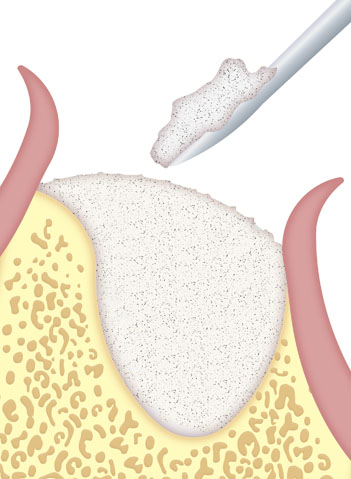dental line
BosHa
evolution

BOS-HA EVOLUTION is the line of hydroxyapatite dental biomaterials from TISSUM BIOMATERIALES.
They are obtained through the exclusive TISSUM TECH production process by InBiomed which allows the purification of cancellous bone of bovine origin, eliminating 100% of the organic material present in native bone tissue, obtaining a hydrophilic, of high purity hydroxyapatite (tricalcium phosphate) matrix, preserving the natural microstructure.
Its high porosity structure provides excellent OSTEOCONDUCTIVE properties, serving as a structural scaffold to preserve tissue regeneration space, providing safety and predictability at the implant site.
BOS-HA EVOLUTION comes in different particle sizes and contents, offering a wide range of options for different clinical applications.
BOS-HA EVOLUTION is remodeled in the osseointegration process once implanted, allowing the patient’s own bone to form at the implant site.
bovine hydroxyapatite, hydroxyapatite mineral matrix of bovine origin for bone replacement and guided regeneration.
Composition:
active substance hydroxiapatite of 100% bovine origin.
Presentations/models:
| Code | Particle size |
|---|---|
| F | < 210 µm |
| N | 210 - 1000 µm |
| G | 1,000 - 2,000 µm |
| EG | > 2,000 µm |
FEATURES
Biomaterial of bovine origin with a microstructure similar to that of mineralized human bone. It has a high porosity structure, which allows internal cell migration, favoring angiogenesis (formation of blood vessels) and osteogenesis (creation of new bone).
The high-temperature BOS-HA® processing assures the complete removal of organic material present in native bovine bone, which eliminates possible immunogenic reactions. It offers the specialist surgeon the following properties:
Hydrophilic
Osteoconductive
Due to its slow reabsorption rate, it behaves as an excellent support scaffold at the implant site, which preserves the volume of the graft in the long term.
Microstructure similar to that of human bone.
CLINICAL INDICATIONS
Bone substitute in medical surgeries.
Loss of bone substance, need for augmentation and filling of cavities that must be covered with bone tissue.
Filling of bone cavities in traumatology, dentistry and ophthalmology.
Bone reconstruction and regeneration in traumatology, dentistry and ophthalmology.
Bone reconstruction and regeneration in spinal surgery.
Filler in ocular evisceration and enucleation.
Filler material in the eye socket.
Cranioplasties.
Maxillofacial surgery.
Other clinical indications.
Moisten with sterile saline solution or the patient’s own blood before implantation.
Apply the material to the defect using sterile instruments.
Ensure optimal contact between the bone filling and the recipient bone in order to ensure correct osteoinduction.
Modulate with spatula, if necessary.
Avoid excess product in the defect.
Place a membrane to protect the soft tissue graft, in cases where this type of protection is required.
The implant specialist must take into account the strength of the bone filling when loading it and, where appropriate, placing a support structure.
Ensure the correct immobilization of the filling in order to avoid micro movements that could generate a fibrous encapsulation.The surgical technique described must be carried out exclusively in an appropriate environment and with sterile instruments.
To facilitate bone neoformation, the implanted material must be in direct contact with bone walls with good vascularization and, in certain cases, it is recommended to prepare the patient’s bone tissue with a bur.
In the case of large cavities, a mixture of this biomaterial with autologous bone can improve neoformation.
Implantology (Dentistry): Experience shows that in areas where bone mass has increased, mechanical load or the definitive insertion of implants should not be applied until at least 4 to 6 months have elapsed from the insertion of the material.
Periodontics (Dentistry): Before applying the biomaterial, it is necessary to perform a correct treatment of the periodontal lesion by root scaling, curettage and other appropriate procedures.
Traumatology: In cases of large fillings, the final mechanical properties in the regenerated area may not be identical to those that would have been obtained with an autologous transplant.
Discard any remnants and do not attempt to resterilize the biomaterial. Do not use after the expiration date.




